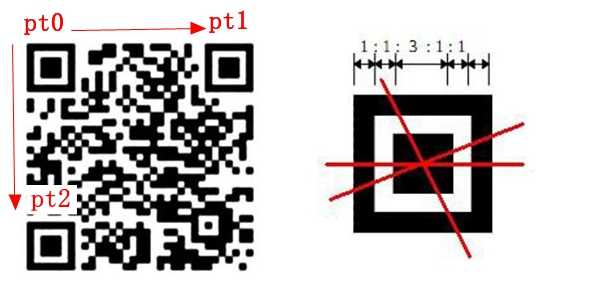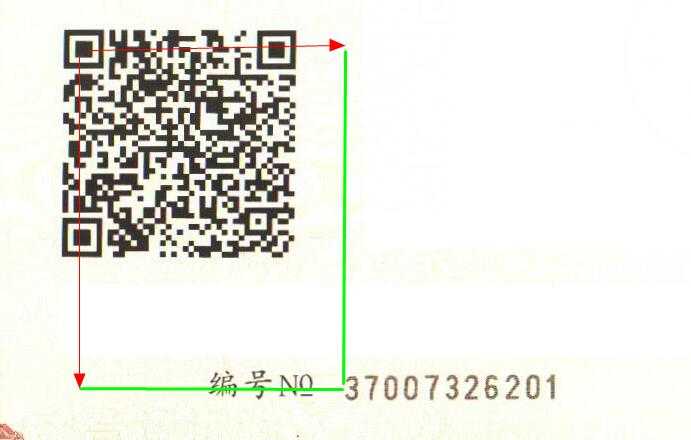org.apache.shiro.util.bytesource 啥类型
Posted
tags:
篇首语:本文由小常识网(cha138.com)小编为大家整理,主要介绍了org.apache.shiro.util.bytesource 啥类型相关的知识,希望对你有一定的参考价值。
参考技术A java.io.NotSerializableException: org.apache.shiro.util.SimpleByteSource是由于 SimpleByteSource 没有实现序列化接口导致。在集成redis缓存, 开启缓存认证时候报错我的解决方案 写一个新类去继承SimpleByteSource,并实现序列化接口 public class MySimpleByteSource extends SimpleByteSource implements Serializable public MySimpleByteSource(byte[] bytes) super(bytes);// TODO Auto-generated constructor stub 在处理认证中 protected AuthenticationInfo doGetAuthenticationInfo(AuthenticationToken token) throws AuthenticationException return new SimpleAuthenticationInfo(model, user.getPassword(), new MySimpleByteSource(salt), getName()); org.apache.shiro.util.bytesource 什么类型本回答被提问者和网友采纳基于opencv 识别定位二维码 (c++版)
前言 因工作需要,需要定位图片中的二维码;我遂查阅了相关资料,也学习了opencv开源库。通过一番努力,终于很好的实现了二维码定位。本文将讲解如何使用opencv定位二维码。
定位二维码不仅仅是为了识别二维码;还可以通过二维码对图像进行水平纠正以及相邻区域定位。定位二维码,不仅需要图像处理相关知识,还需要分析二维码的特性,本文先从二维码的特性讲起。
1 二维码特性
二维码在设计之初就考虑到了识别问题,所以二维码有一些特征是非常明显的。
二维码有三个“回“”字形图案,这一点非常明显。中间的一个点位于图案的左上角,如果图像偏转,也可以根据二维码来纠正。

思考题:为什么是三个点,而不是一个、两个或四个点。
一个点:特征不明显,不易定位。不易定位二维码倾斜角度。
两个点:两个点的次序无法确认,很难确定二维码是否放正了。
四个点:无法确定4个点的次序,从而无法确定二维码是否放正了。
识别二维码,就是识别二维码的三个点,逐步分析一下这三个点的特性
1 每个点有两个轮廓。就是两个口,大“口”内部有一个小“口”,所以是两个轮廓。
2 如果把这个“回”放到一个白色的背景下,从左到右,或从上到下画一条线。这条线经过的图案黑白比例大约为:黑白比例为1:1:3:1:1。
3 如何找到左上角的顶点?这个顶点与其他两个顶点的夹角为90度。
通过上面几个步骤,就能识别出二维码的三个顶点,并且识别出左上角的顶点。
2 使用opencv识别二维码
1) 查找轮廓,筛选出三个二维码顶点
opencv一个非常重要的函数就是查找轮廓,就是可以找到一个图中的缩所有的轮廓,“回”字形图案是一个非常的明显的轮廓,很容易找到。
1 int QrParse::FindQrPoint(Mat& srcImg, vector<vector<Point>>& qrPoint) 2 3 //彩色图转灰度图 4 Mat src_gray; 5 cvtColor(srcImg, src_gray, CV_BGR2GRAY); 6 namedWindow("src_gray"); 7 imshow("src_gray", src_gray); 8 9 //二值化 10 Mat threshold_output; 11 threshold(src_gray, threshold_output, 0, 255, THRESH_BINARY | THRESH_OTSU); 12 Mat threshold_output_copy = threshold_output.clone(); 13 namedWindow("Threshold_output"); 14 imshow("Threshold_output", threshold_output); 15 16 //调用查找轮廓函数 17 vector<vector<Point> > contours; 18 vector<Vec4i> hierarchy; 19 findContours(threshold_output, contours, hierarchy, CV_RETR_TREE, CHAIN_APPROX_NONE, Point(0, 0)); 20 21 //通过黑色定位角作为父轮廓,有两个子轮廓的特点,筛选出三个定位角 22 int parentIdx = -1; 23 int ic = 0; 24 25 for (int i = 0; i < contours.size(); i++) 26 27 if (hierarchy[i][2] != -1 && ic == 0) 28 29 parentIdx = i; 30 ic++; 31 32 else if (hierarchy[i][2] != -1) 33 34 ic++; 35 36 else if (hierarchy[i][2] == -1) 37 38 ic = 0; 39 parentIdx = -1; 40 41 43 //有两个子轮廓才是二维码的顶点 44 if (ic >= 2) 45 46 bool isQr = QrParse::IsQrPoint(contours[parentIdx], threshold_output_copy); 47 48 //保存找到的三个黑色定位角 49 if (isQr) 50 qrPoint.push_back(contours[parentIdx]); 51 52 ic = 0; 53 parentIdx = -1; 54 55 56 57 return 0; 58
找到了两个轮廓的图元,需要进一步分析是不是二维码顶点,用到如下函数:
bool QrParse::IsQrPoint(vector<Point>& contour, Mat& img) //最小大小限定 RotatedRect rotatedRect = minAreaRect(contour); if (rotatedRect.size.height < 10 || rotatedRect.size.width < 10) return false; //将二维码从整个图上抠出来 cv::Mat cropImg = CropImage(img, rotatedRect); int flag = i++; //横向黑白比例1:1:3:1:1 bool result = IsQrColorRate(cropImg, flag); return result;
黑白比例判断函数:
1 //横向和纵向黑白比例判断 2 bool QrParse::IsQrColorRate(cv::Mat& image, int flag) 3 4 bool x = IsQrColorRateX(image, flag); 5 if (!x) 6 return false; 7 bool y = IsQrColorRateY(image, flag); 8 return y; 9 10 //横向黑白比例判断 11 bool QrParse::IsQrColorRateX(cv::Mat& image, int flag) 12 13 int nr = image.rows / 2; 14 int nc = image.cols * image.channels(); 15 16 vector<int> vValueCount; 17 vector<uchar> vColor; 18 int count = 0; 19 uchar lastColor = 0; 20 21 uchar* data = image.ptr<uchar>(nr); 22 for (int i = 0; i < nc; i++) 23 24 vColor.push_back(data[i]); 25 uchar color = data[i]; 26 if (color > 0) 27 color = 255; 28 29 if (i == 0) 30 31 lastColor = color; 32 count++; 33 34 else 35 36 if (lastColor != color) 37 38 vValueCount.push_back(count); 39 count = 0; 40 41 count++; 42 lastColor = color; 43 44 45 46 if (count != 0) 47 vValueCount.push_back(count); 48 49 if (vValueCount.size() < 5) 50 return false; 51 52 //横向黑白比例1:1:3:1:1 53 int index = -1; 54 int maxCount = -1; 55 for (int i = 0; i < vValueCount.size(); i++) 56 57 if (i == 0) 58 59 index = i; 60 maxCount = vValueCount[i]; 61 62 else 63 64 if (vValueCount[i] > maxCount) 65 66 index = i; 67 maxCount = vValueCount[i]; 68 69 70 71 72 //左边 右边 都有两个值,才行 73 if (index < 2) 74 return false; 75 if ((vValueCount.size() - index) < 3) 76 return false; 77 78 //黑白比例1:1:3:1:1 79 float rate = ((float)maxCount) / 3.00; 80 81 cout << "flag:" << flag << " "; 82 83 float rate2 = vValueCount[index - 2] / rate; 84 cout << rate2 << " "; 85 if (!IsQrRate(rate2)) 86 return false; 87 88 rate2 = vValueCount[index - 1] / rate; 89 cout << rate2 << " "; 90 if (!IsQrRate(rate2)) 91 return false; 92 93 rate2 = vValueCount[index + 1] / rate; 94 cout << rate2 << " "; 95 if (!IsQrRate(rate2)) 96 return false; 97 98 rate2 = vValueCount[index + 2] / rate; 99 cout << rate2 << " "; 100 if (!IsQrRate(rate2)) 101 return false; 102 103 return true; 104 105 //纵向黑白比例判断 省略 106 bool QrParse::IsQrColorRateY(cv::Mat& image, int flag)
bool QrParse::IsQrRate(float rate) //大概比例 不能太严格 return rate > 0.6 && rate < 1.9;
2) 确定三个二维码顶点的次序
通过如下原则确定左上角顶点:二维码左上角的顶点与其他两个顶点的夹角为90度。
1 // pointDest存放调整后的三个点,三个点的顺序如下 2 // pt0----pt1 3 // 4 // pt2 5 bool QrParse::AdjustQrPoint(Point* pointSrc, Point* pointDest) 6 7 bool clockwise; 8 int index1[3] = 2,1,0 ; 9 int index2[3] = 0,2,1 ; 10 int index3[3] = 0,1,2 ; 11 12 for (int i = 0; i < 3; i++) 13 14 int *n = index1; 15 if(i==0) 16 n = index1; 17 else if (i == 1) 18 n = index2; 19 else 20 n = index3; 21 22 double angle = QrParse::Angle(pointSrc[n[0]], pointSrc[n[1]], pointSrc[n[2]], clockwise); 23 if (angle > 80 && angle < 99) 24 25 pointDest[0] = pointSrc[n[2]]; 26 if (clockwise) 27 28 pointDest[1] = pointSrc[n[0]]; 29 pointDest[2] = pointSrc[n[1]]; 30 31 else 32 33 pointDest[1] = pointSrc[n[1]]; 34 pointDest[2] = pointSrc[n[0]]; 35 36 return true; 37 38 39 return true; 40
3)通过二维码对图片矫正。
图片有可能是倾斜的,倾斜夹角可以通过pt0与pt1连线与水平线之间的夹角确定。二维码的倾斜角度就是整个图片的倾斜角度,从而可以对整个图片进行水平矫正。
1 //二维码倾斜角度 2 Point hor(pointAdjust[0].x+300,pointAdjust[0].y); //水平线 3 double qrAngle = QrParse::Angle(pointAdjust[1], hor, pointAdjust[0], clockwise); 4 5 //以二维码左上角点为中心 旋转 6 Mat drawingRotation = Mat::zeros(Size(src.cols,src.rows), CV_8UC3); 7 double rotationAngle = clockwise? -qrAngle:qrAngle; 8 Mat affine_matrix = getRotationMatrix2D(pointAdjust[0], rotationAngle, 1.0);//求得旋转矩阵 9 warpAffine(src, drawingRotation, affine_matrix, drawingRotation.size());
4)二维码相邻区域定位
一般情况下,二维码在整个图中的位置是确定的。识别出二维码后,根据二维码与其他图的位置关系,可以很容易的定位别的图元。

后记
作者通过查找大量资料,仔细研究了二维码的特征,从而找到了识别二维码的方法。网上也有许多识别二维码的方法,但是不够严谨。本文是将二维码的多个特征相结合来识别,这样更准确。这种识别方法已应用在公司的产品中,识别效果还是非常好的。
以上是关于org.apache.shiro.util.bytesource 啥类型的主要内容,如果未能解决你的问题,请参考以下文章